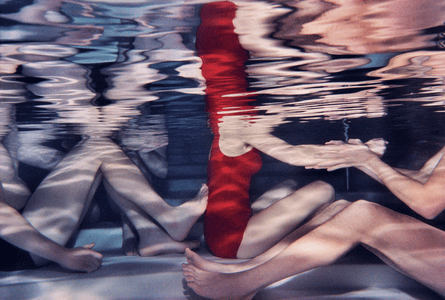Growing up in the suburban Sherman Oaks district of Los Angeles, Larry Sultan lived close to a public swimming pool. His regular visits there were undertaken with a degree of trepidation. “I was petrified of water, of deep water, especially,” he recalled in 1980. “When I was 12, I almost drowned in the ocean. Water is the only bit of nature I know that we can’t control, that seems overwhelming when you enter it and are totally immersed in it.”
In 1974, partly as a way of confronting his own primal fear, Sultan began photographing the participants in a local swimming class for blind people. He abandoned the series soon afterwards and began working on more conceptual projects alongside Mike Mandel, whom he had met at art school in San Francisco. In 1977, the pair published Evidence, an enigmatic book of monochrome found photographs from various American technological and research institutions that is now considered a landmark of conceptual photography. It was both the apex and end point of their creative partnership.
In 1978, inspired by a Red Cross swimming and life-saving manual, Sultan once again began photographing people in the San Francisco area learning to swim. For the following four years, using a small underwater camera and a snorkel, he shot regularly at the Jewish Community Center of San Francisco, the Richmond Plunge and the Recreation Center for the Disabled. Throughout, what he called “the groundlessness of the experience” of swimming in the deep end remained an issue for him and for many of his subjects. It also determined his approach. “I knew I had to get underneath the water to photograph this lack of support, lack of control,” he said, describing how, by doing so, he became a participant in the very experience he was photographing.

The resulting images, titled Swimmers, evoke the sometimes balletic, sometimes ungainly, sometimes sensual dance of submerged bodies in motion: floating, flailing, sinking and resurfacing. The water itself is the defining element, altering his photographic perception and subverting any attempt at capturing the decisive moment. Submerged bodies often appear elongated or distorted, the play of light on water dappling limbs and torsos, sometimes rendering his fellow swimmers translucent, even ghostlike. Here and there, bodies fall though water or are kept afloat with the help of instructors. He later described his time at the Recreation Center as “the most profound experience”.

Sultan found the physicality of photographing bodies partially or totally submerged in water as unsettling as it was liberating, and his own fear is a constant subliminal presence in the images. Formally, too, it was risky, not least because it meant abandoning the more cerebrally driven approach that had characterised the projects he had undertaken with Mandel. Perhaps for this reason, the series seems like a brief, but heady, interruption of his usual practice, neither as conceptually playful as the work that preceded it, nor as formally rigorous as the work that followed it.

Larry Sultan died in December 2009, aged 63, by which time he had reinvented himself once again through meticulously choreographed series such as Pictures From Home, in which he photographed his ageing parents in their sumptuous suburban house in the San Fernando valley, and The Valley, which featured middle-class homes there that had been rented out as sets for porn films.
Painterly and impressionistic, filled with movement and gesture, Swimmers is Larry Sultan’s most instinctive and unselfconscious body of work. A creatively liberating moment that reveals as much, if not more, about the person behind the lens as those in front of it.

